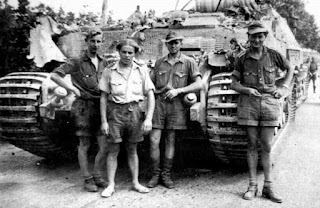A little while back I found out about the Bergehetzer having never heard mention of it before, so I decided to collect photos together for all the different WW2 German recovery vehicles and group in one place as some are far less common than others.
Bergepanzer III
After 1943 the Panzer III had seen its day as a front line tank and hundreds were converted to other functions. Apparently over 150 were converted to Bergepanzers but photos online seem fairly few. They were also converted into munitions carriers, command and observations vehicles. Some prototype assault guns and mine clearance vehicles were made and many of the turrets made it onto fixed fortifications on the Atlantic Wall.
Bergepanzer IV
This one seems very elusive, there are hardly any photos available online, Some appear to have passed through eBay auctions so may have been published somewhere very specialised like the Panzer Tracts books. According to Achtung Panzer, 36 were made but there's not much for the modeller to go on, although Dragon do a 1/35th kit. It seems they plugged the turret ring with wood and added a crane, along with some other fitments for stowage.
Bergepanzer VK.1601
This is an odd one of which only a single photo seems to exist, possibly of only a single vehicle. Only 22of the VK.1601 were made as an experimental run of where there are few photos. Apparently just one was later converted in 1944 into a bergpanzer.
Bergetiger
In late 1944 a 'Bergetiger' was found abandoned in Anizo. There are several photos of this vehicle but facts beyond this are debated. Some say it was a unique field conversion, others commonly say three were purpose made, some say any more but I think that rather unlikely given how little evidence of their existence there is. No one is quite sure what it was for either. Dubbed a 'bergetiger' by allied forces it doesn't seem capable of recovering vehicles due to the small crane and winch. Unlike more recovery vehicles it still has the turret, although modified, which suggests a quick field conversion. Together these things would have prevented it towing vehicles or even performing many maintenance task. Some suggest it had a role in laying demolition charges.
Bergetiger (P)
Many photos exist of this one despite only three being made. When the Tiger (P) was turned down in favour of the Henschel chassis, Porsche had already made nearly 100 VK.4501 chassis. These were not wasted and 91 Ferdinands were made. Around half of these were lost at Kursk and were refitted to become the Elefant. Of the original VK.4501 chassis five were mounted with the Krupp turret and one was used as Tiger (P) command vehicle. In late 1943 three of these five were converted into the recovery vehicles. Supposedly at least one other was to be turned into the Rammtiger but no real evidence supports this.
The Tiger (P) hull was altered with the turret removed, the engine moved to the middle, a small raised structure in the back and fitted with a two ton crane.
Bergepanzer 38(t)
Or perhaps Bergehetzer, some 170 of these were made on a mixture of Panzer 38(t) and reused Hetzer chassis. This seems a huge number given how rarely seen it is, there are fairly few photos around and few give hints as to the layout of the interior. 30 were further used as the basis for a 150mm howitzer carrier. One made it to Aberdeen in the US but was scrapped after testing,
Bergepanther
There seem to be a wealth of photos of the Bergepanther as nearly 350 were built. Unlike other vehicles retrofitted with recovery gear, these appear to have been mostly purpose built for the task. Later on vehicles were repaired and delivered as Panthers without the turret, lacking a winch making them towing vehicles only, but still described as Bergepanthers. Some had their recovery equipment removed and were used as ammunition carriers.
The Panther chassis made it heavily armoured and it could tow the largest vehicles, even potentially under fire. Some continued to be used after the war by the French army into the 1950s and a couple survive in museums or collections today.
Bergewagen
The Tiger II chassis was supposedly used to make 18 Bergewagens but there's no real evidence of this, so file it along with the Rammtiger and E-100 turret. It also seems a bit redundant alongside the Bergepanther which could tow the larger vehicles. Some pictures included for the sake of completeness show a Tiger II chassis with towing fitments, the vehicle possibly being used to clear wreckage.











































